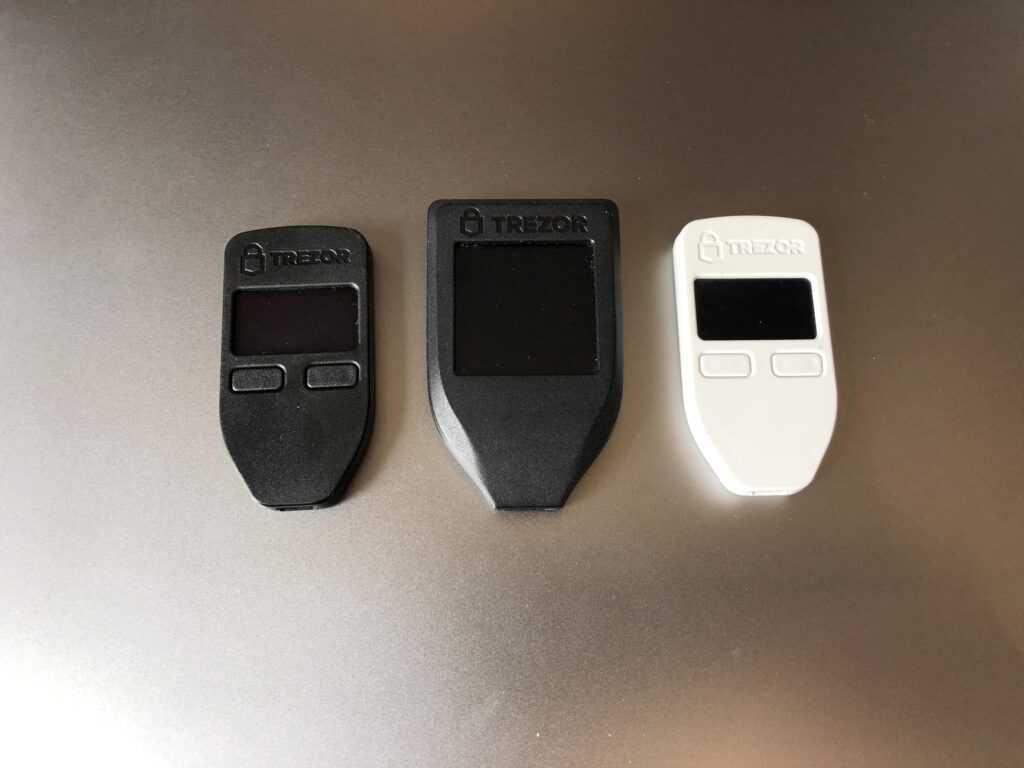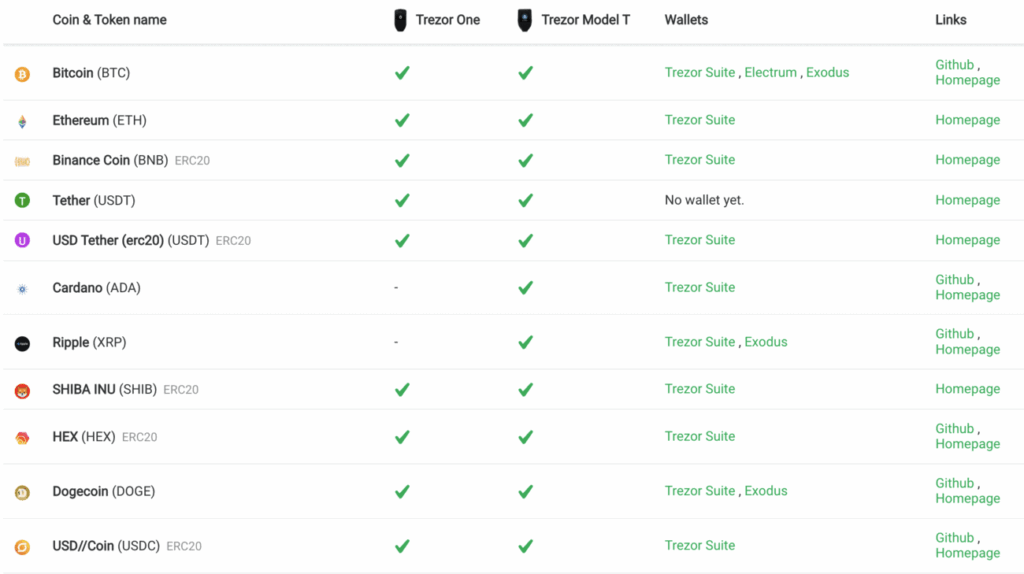Trezor One and Trezor Model T are cryptocurrency hardware wallets released by SatoshiLabs in 2014 and 2018. As of 2025, Trezor One remains a solid choice for budget users or those with simpler portfolios. For users seeking broader coin support and a touchscreen interface, the Model T is worth the premium.
In this article, we compare both wallets and offer our updated verdict on which one fits your needs best in 2025.
For an in-depth look at each device, check out our Trezor One Review and Trezor Model T review.

Who is Trezor One for?
- Those who care about affordability. Retailing at 69 EUR, it is relatively affordable as a mainstream branded hardware wallet.
- Users who just want to trade the major coins. The Trezor One has comparatively fewer supported coins.
- Those interested in a smaller, more portable wallet. It is lighter and around 20% smaller than the Model T.
Get your Trezor One here.
Who is Trezor Model T for?
- Sophisticated traders who trade or are interested in trading numerous different altcoins. For example the Trezor One does not support Ripple (XRP), Cardano (ADA), Solana (SOL) and a number of later ERC-20 coins.
- Users who want clear and vivid displays: The Model T has an almost 2x larger colour touch screen.
Get your Trezor Model T here.
Security Features
Trezor hardware wallets continue to be among the most secure options for storing cryptocurrency. Both the Trezor One and Trezor Model T are developed by SatoshiLabs and receive regular firmware updates to address vulnerabilities and improve user protection.
Core Security Architecture
- Open-source firmware and hardware allow for independent audits and community verification.
- Trezor does not use a closed-source secure element. Instead, it relies on a hardened microcontroller and software-based security architecture.
- Devices ship with tamper-evident packaging to detect physical interference.
PIN, Passphrase, and Recovery Phrase
- PIN code can be up to 50 digits and is required to unlock the device.
- Passphrase is optional but recommended. It adds an extra layer of protection and enables hidden wallets.
- Recovery phrase consists of 12 to 24 words and is used to restore access if the device is lost or damaged.
Physical Vulnerability Disclosure
In 2020, Kraken Security Labs disclosed a hardware vulnerability affecting both models that allows PIN extraction if an attacker has physical access. This issue stems from the microcontroller design and cannot be fixed via firmware. SatoshiLabs has implemented several mitigations:
- Passphrase protection, when enabled, neutralizes the vulnerability.
- Firmware updates have hardened the software to reduce attack vectors and improve resilience.
As of 2025, no successful remote exploits have been reported for either device. Users are advised to enable passphrase protection, store recovery phrases securely offline, and keep firmware updated through Trezor Suite.
Input Method Differences
- Trezor One requires PIN, passphrase, and recovery phrase to be entered via the connected computer or mobile device.
- Trezor Model T allows all sensitive inputs to be entered directly on the device’s touchscreen, reducing exposure to malware on host devices.
Multicurrency Support
This is one of the clearest areas where the differences between the Trezor One and Model T show up—especially with the rapid evolution of the crypto space.

Trezor One
Supports over 1,000 coins and tokens, including major assets like:
- Bitcoin (BTC)
- Ethereum (ETH) and all ERC-20 tokens
- Litecoin (LTC), Bitcoin Cash (BCH), Dogecoin (DOGE), Ethereum Classic (ETC), and Chainlink (LINK)
Does not support newer or more complex assets natively, such as:
- Cardano (ADA)
- Ripple (XRP)
- Solana (SOL)
- Monero (XMR)
Some unsupported coins may be accessible via third-party wallet apps, but this requires extra setup and technical know-how.
Trezor Model T
- Supports over 1,400 coins and tokens, with broader native compatibility including:
- Cardano (ADA)
- Ripple (XRP)
- Solana (SOL)
- Tezos (XTZ), EOS, BNB, and SPL tokens
- Also handles ERC-20 tokens, Ethereum Layer 2 tokens (e.g., Polygon/MATIC), and NFTs on supported blockchains
- Ideal for users with diverse portfolios or who want access to DeFi ecosystems and newer altcoins
Click here for a full list of the cryptocurrencies supported by the two devices.
Hardware Design
Both Trezor devices maintain a minimalist, durable design philosophy, but they differ significantly in usability and interface.
Trezor One
- Compact and lightweight: measures 60mm x 30mm x 6mm and weighs just 12 grams
- Monochrome OLED display with 128 × 64 pixel resolution
- Two physical buttons for navigation and confirmation
- Connects via USB-A (micro-B) cable
- Available in black and white
- No battery; powered via external USB connection
- Ultrasonically welded plastic casing for tamper resistance
- Supports U2F standard and includes optional password manager via Chrome extension
Trezor Model T
- Slightly larger: 64mm x 39mm x 10mm and weighs 22 grams
- Full-color LCD touchscreen with 240 × 240 pixel resolution
- Touchscreen interface allows PIN and passphrase entry directly on the device
- Uses USB-C connection for faster and more durable connectivity
- Supports Shamir Backup (SLIP-0039) for advanced recovery options
- MicroSD card slot for hidden wallets and plausible deniability
- Fully open-source firmware with customizable security settings
- Designed for enhanced usability and privacy, especially in high-risk environments
Both devices are compatible with Windows, macOS, Linux, and Android, and integrate seamlessly with the Trezor Suite app.
Verdict
Both Trezor One and Trezor Model T remain excellent choices for securing digital assets, but they cater to different types of users.
Trezor One
- Still one of the most affordable and reliable hardware wallets on the market
- Ideal for users who primarily hold major cryptocurrencies like Bitcoin and Ethereum
- Simple interface with physical buttons appeals to those who prefer tactile control
- Lacks support for newer coins and advanced features, but remains secure and effective for basic use
- Priced around $69, making it a great entry-level option
Trezor Model T
- Designed for users with diverse portfolios and advanced security needs
- Supports over 1,400 cryptocurrencies, including Cardano, Solana, and newer ERC-20 tokens
- Features a full-color touchscreen, USB-C connectivity, and MicroSD slot for hidden wallets
- Includes Shamir Backup for enhanced recovery options
- Open-source firmware and advanced privacy tools make it a favorite among security-conscious users
- Priced around $219, reflecting its premium build and broader functionality
If your crypto holdings are limited to major coins and you want a straightforward, budget-friendly device, the Trezor One is still a solid pick. But if you’re active in DeFi, hold a wide range of assets, or want the most secure and flexible experience available, the Trezor Model T is the clear winner in 2025.
Further reading
Want to know how the Trezor stacks up against other brands? Check out our comparison of the top 3 cryptocurrency hardware wallets!